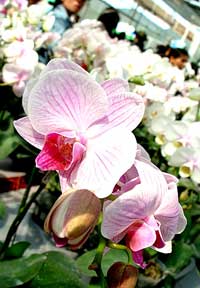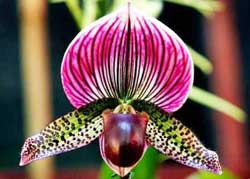 Biologists at the Dalat Nuclear Research Institute have perfected the process of producing orchid growing substrates from agricultural by-products in Lam Dong province.
Biologists at the Dalat Nuclear Research Institute have perfected the process of producing orchid growing substrates from agricultural by-products in Lam Dong province.
Master Nguyen Duy Hang, the head of this research project, stated: “Our goal is to study the production of synthetic substrates for growing orchids and ornamental plants in Lam Dong using locally available agricultural by-products through biological methods. This aims to gradually replace the natural resources currently being exploited, such as sphagnum moss, which is becoming increasingly depleted. Based on this research, we apply it to practical production to enhance the yield and quality of flowers, reduce deforestation, and improve the ecosystem, thereby increasing economic efficiency.”
Nguyen Duy Hang’s research team utilized various by-products such as sugarcane bagasse, corn cobs, peanut shells, and coffee husks, all of which can be utilized in organic fertilizer production thanks to heat-resistant microbial strains capable of decomposing these by-products into substrates for flower cultivation. This method is applicable not only for orchids but also for various other types of flowers and ornamental plants, serving as a replacement for traditional substrates.
Over the past two years, with the budget allocated for scientific and technological research from Lam Dong province, the authors have been facilitated by the province to research and establish a production process for synthetic substrates for growing orchids from agricultural by-products using microbial fermentation methods. This synthetic substrate is produced from organic matter derived from plants, aerobic microorganisms, and macronutrients, as well as microelements, making it highly suitable for cultivating orchids and other types of flowers and ornamental plants.
This synthetic substrate can be produced in the form of pellets or fibers with a nutrient composition of: organic matter 47%; total nitrogen 0.8%; phosphorus 0.7%; total potassium 1%; calcium oxide 0.3%; magnesium oxide 0.3%; sulfur (S) 0.1%; and trace elements such as Zn, Mo, Mn, Cu, B, etc. Additionally, the substrate contains compounds with high biological activity, which help the plants develop disease resistance. Some beneficial microorganisms can inhibit certain pathogenic fungi affecting the roots.
 Through experimental results, cultivation has been successful on various types of plants, especially orchids at different ages. This substrate promotes the growth and development of orchids with a well-developed root system that easily absorbs nutrients, maintaining appropriate aeration and water retention.
Through experimental results, cultivation has been successful on various types of plants, especially orchids at different ages. This substrate promotes the growth and development of orchids with a well-developed root system that easily absorbs nutrients, maintaining appropriate aeration and water retention.
Quick to adopt new techniques, many orchid growers have approached the Biotechnology Department at the Dalat Nuclear Research Institute to request being selected as a trial model for technology transfer.
The project is currently being further developed in the direction of trial projects and large-scale production to meet the needs of local farmers.


















































